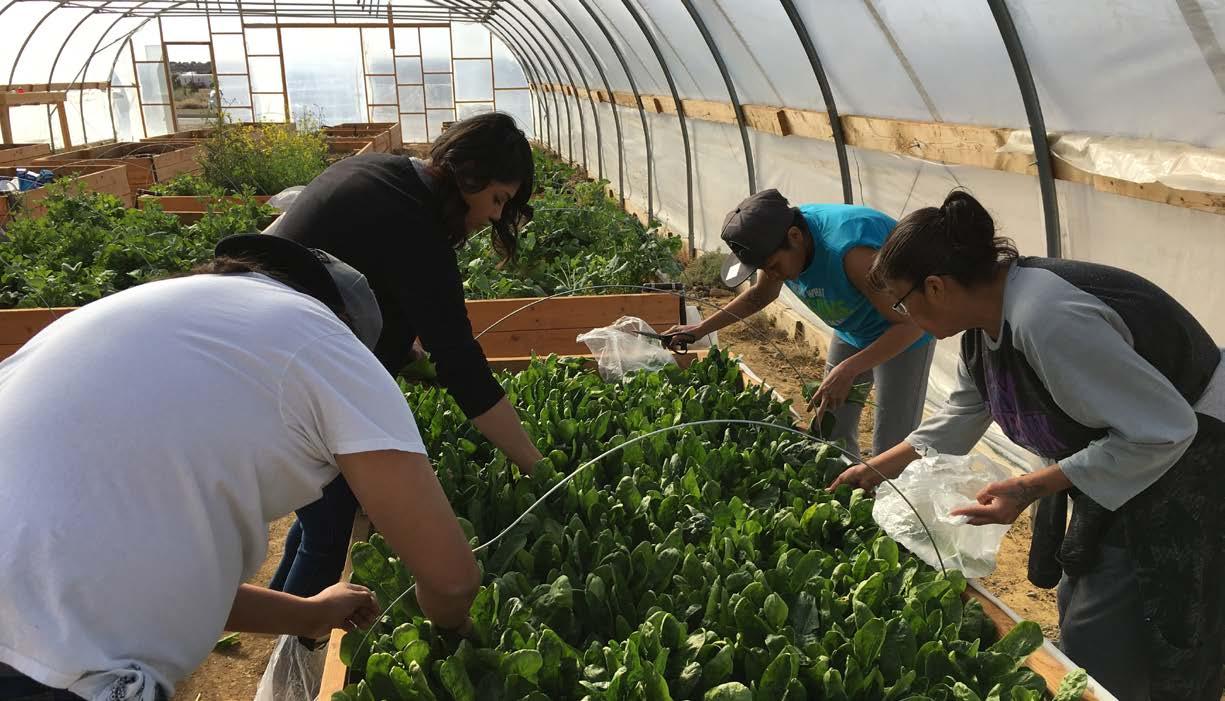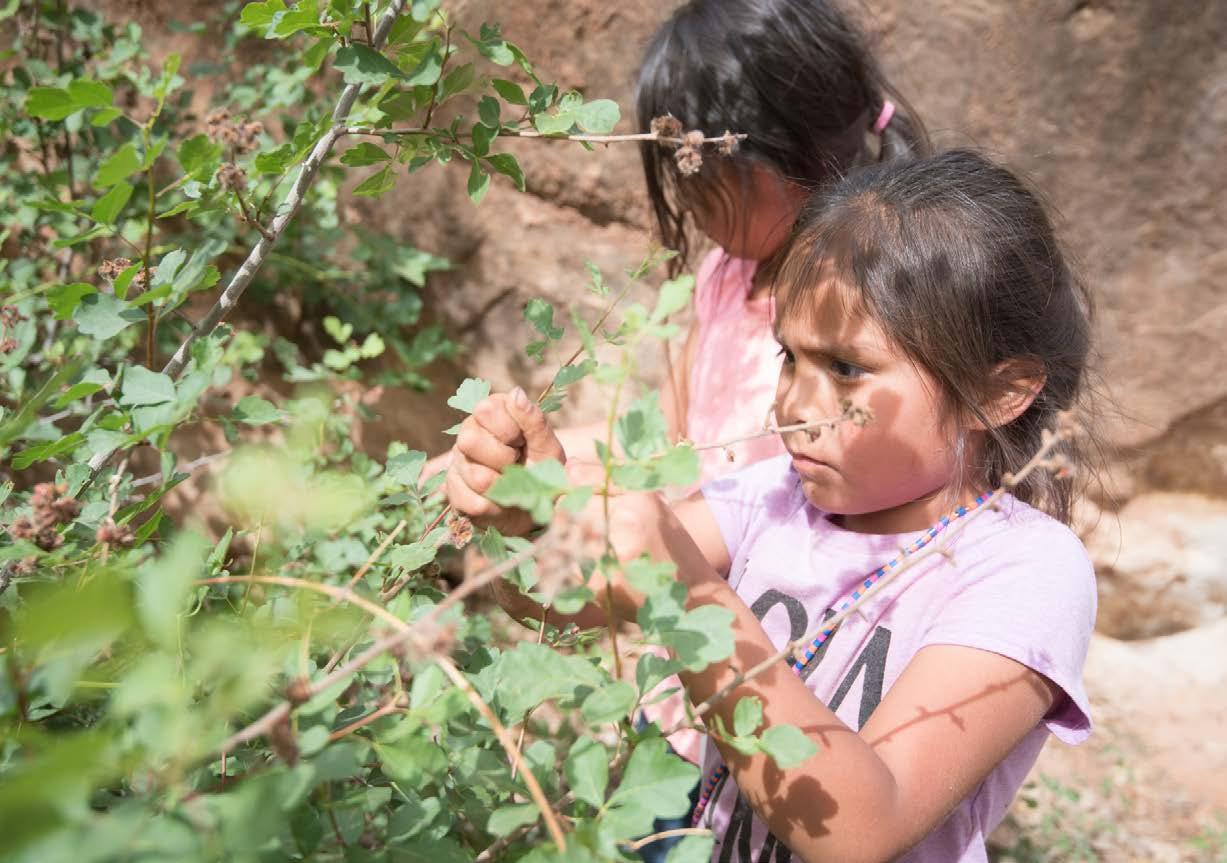
3 minute read
ADVANCING TRADITIONAL COMMUNITY-BASED AGRICULTURE
Native Tribes on the Colorado Plateau developed advanced techniques in dryland farming, cultivating resilient plant varieties that sustained their communities for generations. Farming continues to occupy a large role in the traditional lifeways of Native people.
In our upbringing, food has many values and it’s viewed in a holistic way – food as a living, breathing being. Food is tied to our ceremonies, songs, and stories of how we have a reciprocal relationship with our plant relatives and the four-legged beings. We communicate with an exchange of gifts through offerings and prayers. This interconnected relationship of how food and nutrition brings healing to the mind, body, and spirit is not being spoken of in the Western context.
– Cynthia Wilson
This traditional food, it’s more nutritious. It’s literarily part of our culture. You know, your grandmother, your great-great grandparents probably had their hands on this corn at one point, and that’s part of our heritage, part of our land and this is what your body recognizes in good food.
– Aaron Lowden
As Indigenous people, we think about getting up in the morning with the sunrise, working so that we can live through the day and just ensuring that we’re getting ready for the next season or getting ready for the next year, and looking at your family and where you are in that cycle. And those things were interrupted by having this 40-hour week come in and now you’re going to get paid every two weeks and you’re going to have money to spend. The way of life we had was built around our time, our days or months, and our seasons. Whereas a 40-hour work week, you do that all day, you know, every day. There’s not really a season that you work or don’t work.
– Jessica Stago
For us, as Hopi, we refer to our crops as children. As farmers, we plant our young ones in the earth with a 20 day birthing ceremony. This is the time that the child is introduced into this world, he or she is linked to the father’s clan and their name is announced to our father, the sun. This is the time that the child becomes culturally and spiritually grounded into the earth. We feed our children our own foods first, not only because their bodies are nourished spiritually by this act, but also so that they receive the superior nutrition, immunity, and physical and spiritual resistance to disease that our traditional foods provide.
– Valerie Nuvayestewa
One of the many impacts of colonialism has been both a departure from traditional community-based agriculture and a deficit of stores from which Native people can buy healthy food. For example, the Navajo Nation, which is an equivalent size to the state of West Virginia, has only 13 grocery stores to cover 27,000 square miles. The average resident drives three hours for groceries.33 In a 2014 survey of Navajo Nation tribal members’ shopping preferences, 51% of respondents preferred to purchase groceries off the reservation due to lower prices and a greater variety of foods. Of the five towns included in the survey, the shortest roundtrip distance to an off-reservation grocery store was 155 miles.34 Figure 4 shows the percentage of tribal households on the Colorado Plateau living more than ten miles from a supermarket.35 This study does not account for smaller grocery stores, convenience stores, and other retail outlets — which, though more prevalent in tribal areas and more accessible — are less likely to offer a large selection of fresh, healthy foods. Since the survey was completed, Zuni established a locally owned market called Halona Market Place; however, its selection is limited and not as extensive as a major chain market in the nearest city, which is more than 40 miles away. Therefore, results for the Zuni Pueblo were not altered in Figure 4 below.
Source: This graph was created using data from Tables A-1 and Table A-6 from Kaufman, P., Dicken, C., & Williams, R. (2014, December). Measuring access to healthful, affordable food in American Indian and Alaska Native Tribal areas, EIB-131. U.S. Department of Agriculture, Economic Research Service.
We have so many issues now because of the food we’re eating currently. And the lack of access to food, to good food…You don’t realize how important food is until you don’t have it and you don’t realize how much we’re dependent on these outside systems. I constantly think, “What would happen if there was no Walmart 20 miles
MODERN NATIVE LEADERSHIP IN FOUR KEY AREAS MODERN NATIVE MOVEMENT-BUILDING ON THE COLORADO PLATEAU down the road? What would happen if there weren’t all these trucks and trains that bring in all this food from all over the country just to meet our needs? What would happen, what would happen to our people and how many people will be able to feed themselves?” And really that’s what it boils down to: how do we feed ourselves?
– Aaron Lowden
Severe impacts result from this supply deficit and the decline of sustainable community-based agricultural traditions. A long-term study of the Pima Indian Tribe in southern Arizona showed that those who reported consuming a Western diet were 2.5 times more likely to develop diabetes than those consuming a diet of predominantly traditional foods.36 Several short-term studies of Native communities show that return to a traditional diet is associated with improvements in metabolic abnormalities such as glucose intolerance and high cholesterol, triglyceride, and insulin levels.37
Beyond public health, manifold connections exist between sustainable community-based agriculture, traditional foods, and the overall health of Native people and their cultures.









